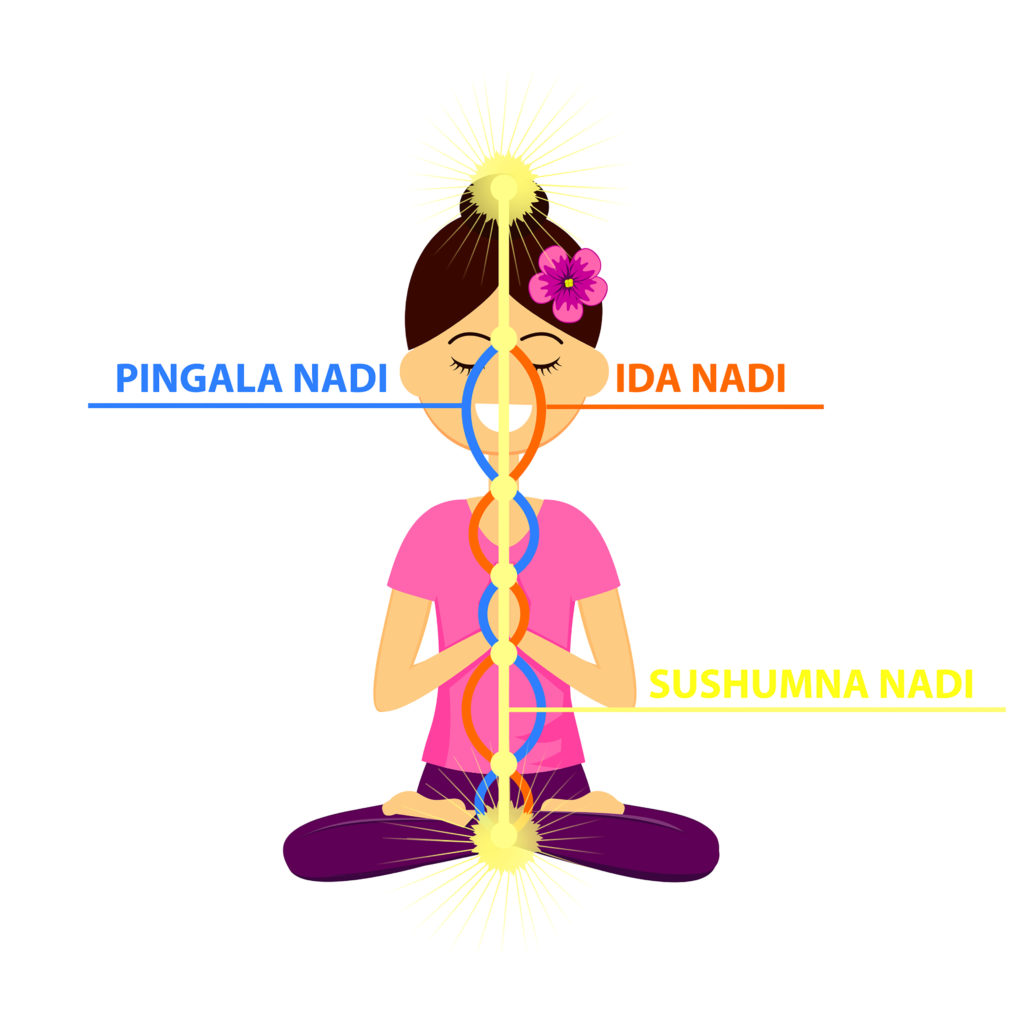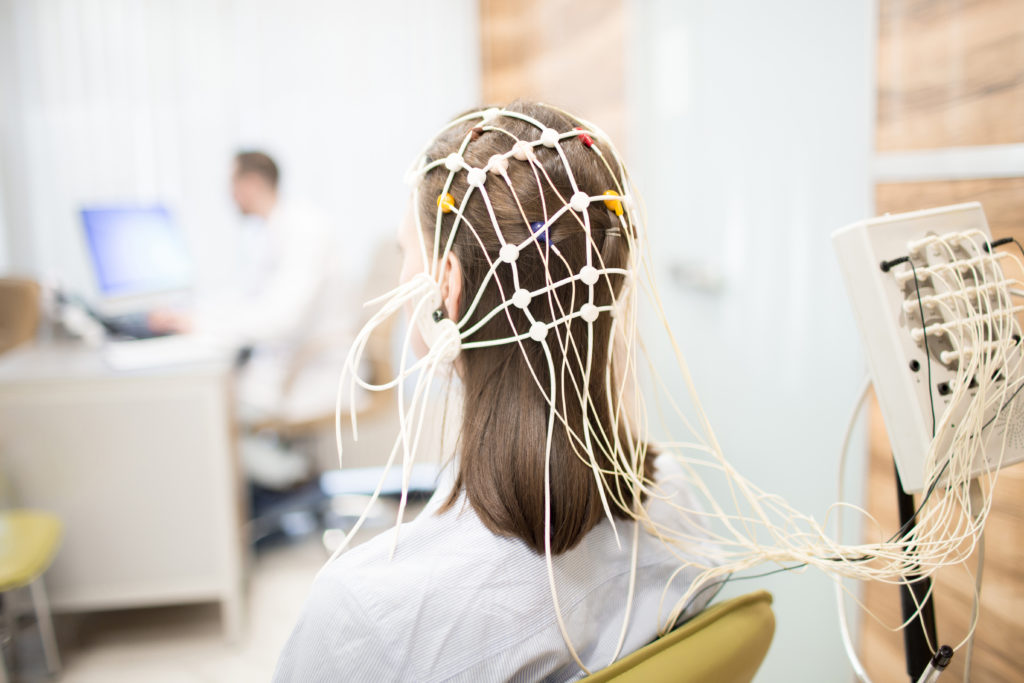If you’ve ever been in a yoga class or sat in on a breathwork session, you may have had someone instruct you to practice “alternate nostril breathing” in which you are told to use a finger to “close” one nostril, breathe through the other, and then switch sides and do the same.
And, you may have wondered why in the world it mattered which nostril you inhaled through — after all, it’s all the same air and your nostrils are the same, right?
The practice is called Nadi Shodhana and Vedic tradition claims that it creates a more alert and calm mind – and a generally more well state of being. But is this just woo-woo myth?
Maybe not. But we’ll get to that in a moment.
The Roots of Nadi Shodhana
According to the Yogis, our bodies contain millions of energetic channels, known as Nadis. These channels connect various parts of our body to other parts. And while those millions of channels may all be exchanging information, there are 3 dominant Nadis that the Nadi Shodhana practice impacts – the Ida, Pingala and the Shashuma.
These three particular Nadis start in our pelvis and swirl up the spine and around the Shahuma, where they meet at the nostrils — the Ida at left nostril and the Pinga at the right.

The Ida and the Pingala crisscross throughout the body. Every few hours, one nostril is dominant. This dominant nostril concept aligns perfectly with the Western medicine principle of the Nasal Cycle. The concept of the Nasal Cycle is the observation that our nostrils are lined with tissue that swells and shrinks throughout the day. As it does, this process results in a “dominant nostril” every few hours.
According to tradition, observing your nasal cycle can give you an idea as to when you might do certain tasks to be most productive and in tune with your body’s natural cycle.
According to this view, the left nostril, connecting to the Ida Nadi, releases a cooling, calming energy, and increases introspection, receptivity, and other perspectives. It is also purported to influence our creativity and intuition and to encourage us to be more in tune with our senses.
Therefore, when left nostril is more dominant (meaning when it is less “plugged up”), the right hemisphere of the brain becomes more dominant. Tradition holds that the left nostril engages your parasympathetic nervous system, calming you, reducing your heart rate, and lowering your blood pressure.
The right nostril, connecting to the Pingala, increases sympathetic activity, linked with assertiveness, heat, focus, and single-minded thinking.
According to the practice, when the right nostril is more dominant, the left hemisphere of the brain is likewise more dominant. The left hemisphere controls the right side of the body and is associated with linear thinking, logical decisions, the more alert, and active sympathetic nervous system, increasing blood pressure, heart rate, and creating warmth.
These two channels cross back and forth over the third dominant channel, the Sushumna Nadi, which maintains balance between the other two.
Does Science Prove the Nadi Shodhana Claims?
That’s what tradition holds and why yogis and others maintain the practice. But does this ancient practice align with modern scientific understanding?
It does!
Recent findings show that unilateral nasal breathing (the scientific term for Nadi Shodhana) can impact:
- Blood glucose regulation
- Increased heart rate variability
- Decrease in blood pressure
- Improve cardiovascular and pulmonary function (like all nasal breathing)
But most fascinating and exciting is a new study by Niazi, Navid and Bartley published in Nature. It shows that unilateral nasal breathing impacts the left and right hemispheres of the brain, as well as anterior and posterior lobule parts of the brain respectively.
In the study, 30 individuals practiced natural breathing as a baseline, and then either unilateral nasal breathing on their right or left nasal passageway.
The study found that when participants breathed through the left nostril, all brain frequencies slowed down. However, when participants used the right nostril, alpha, beta, and gamma bands slowed in frequency.

The findings showed that left nostril breathing increased activity of the posterior brain, which is associated with parasympathetic function, meditative states, and greater levels of introspection.
On the other hand, the findings showed that right nostril breathing increased frequencies of the game, alpha, and beta waves in frontal and lateral parts of the brain, implying a greater arousal state, or sympathetic activity.
In other words, the yogis are correct.
How to Practice Nadi Shodhana
So, if the scientific proof has now sold you on this practice (o ye of little faith!), you’re probably wondering how to do it and reap these slow-your-brain-down, calming benefits. It’s simple.
Here’s how it works:
- 1. Finding a comfortable seated position, rest your left hand in your lap, or on your left knee
- 2. Make a “peace sign” with the index and middle fingers of your right hand, and place it between your eyebrows
- 3. Gently seal the right nostril with your thumb and slowly inhale through the left nostril
- 4. Switching the seal to the left nostril, release the thumb and slowly exhale through the right nostril
- 5. Inhale through the right nostril
- 6. Reseal right nostril, and release your ring finger and exhale through the left nostril
- Continue alternating for 9 complete cycles – or as long as feels good to you.
While all slow breathing is undoubtedly beneficial for our health and wellbeing – it is clear that spicing up your breathing practice, and alternating nostrils has benefits to reap. If you’re a fellow Yoga teacher or practitioner – you can comfortably share this exciting news with your students or peers. And most exciting, this practice could potentially be used in a clinical environment as a preventative protocol, or even pill-free therapeutic.
Sources
Keen, A. (2021). This is the Time to Take Yoga Back to Its Original Intentions. The MAPS Institute. https://themapsinstitute.com/taking-yoga-back-to-its-original-intentions/
Joshi, A., Singh, M., Singla, B. B., and Joshi, Sunil. (2011). Enhanced Wellbeing Amongst Engineering Students Through Nadi Shodhan Pranayama (Alernate Nostril Breathing) Training: An Analysis. School of Doctoral Studies (European Union) Journal. http://citeseerx.ist.psu.edu/viewdoc/download?doi=10.1.1.459.3895&rep=rep1&type=pdf#page=114
Wisdom Library. Nadi Sodhana: 1 definition. https://www.wisdomlib.org/definition/nadi-sodhana
Weiss. (2020). What Is The Nasal Cycle? Corpus Christi ENT Sinus & Allergy. https://www.ccentsinus.com/blog-nasal-cycle.html#:~:text=The%20nasal%20cycle%20is%20the,congestion%20this%20generally%20goes%20unnoticed.
Tripathy, M. & Sahu, B. (2019). Immediate Effect of Nadi Shodhana Pranayama on Blood Glucose, Heart Rate and Blood Pressure. ResearchGate. https://www.researchgate.net/publication/335433557_Immediate_Effect_of_Nadi_Shodhana_Pranayama_on_Blood_Glucose_Heart_Rate_and_Blood_Pressure
Bhavanani, A. B., Ramanathan, M., Balaji, R., & Pushpa, D. (2014). Differential effects of uninostril and alternate nostril pranayamas on cardiovascular parameters and reaction time. PubMed Central. https://www.ncbi.nlm.nih.gov/pmc/articles/PMC4097918/
Dane, S., Caliskan, E., Karasen, M. & Oztasan, N. (2009). Brief Communication EFFECTS OF UNILATERAL NOSTRIL BREATHING ON BLOOD PRESSURE AND HEART RATE IN RIGHT-HANDED HEALTHY SUBJECTS. Taylor & Francis Online. https://www.tandfonline.com/doi/abs/10.1080/00207450212019
Araujo, L. (2020). Pause, Sip & Breathe. The MAPS Institute. https://themapsinstitute.com/pause-sip-breathe/
Subbalakshi, NK. & D’ Souza, U. (2004). Immediate effect of nadishodhana pranayama on some selected parameters of cardiovascular, pulmonary and higher functions of brain. ResearchGate. https://www.researchgate.net/publication/242738302_Immediate_effect_of_nadishodhana_pranayama_on_some_selected_parameters_of_cardiovascular_pulmonary_and_higher_functions_of_brain.
Joice, S. (2020). Influence of Nadi Shodhana Pranayama on respiratory functions of postmenopausal women. National Journal of Physiology, Pharmacy and Pharmacology. http://www.njppp.com/fulltext/28-1597379283.pdf
Niazi, I. K., Navid, M. S., Bartley, J., Shepherd, D., Pedersen, M., Bums, G., Taylor, D., and White, D. E. (2022). EEG signatures change during unilateral Yogi nasal breathing. Scientific Reports. https://www.nature.com/articles/s41598-021-04461-8.pdf
Sezer, I., Pizzagalli, D. A., Sacchet, M. D. (2022). Resting-state fMRI functional connectivity and mindfulness in clinical and non-clinical contexts: A review and synthesis. ScienceDirect. https://www.sciencedirect.com/science/article/abs/pii/S0149763422000720
Huang, H. Y. (2009). EEG dynamics of experienced Zen meditation practitioners probed by complexity index and spectral measure. Taylor & Francis Online. https://www.tandfonline.com/doi/abs/10.1080/03091900802602677
Neuroscientifically Challenged. (2022). Know Your Brain: Posterior Parietal Cortex. https://neuroscientificallychallenged.com/posts/know-your-brain-posterior-parietal-cortex
Russo, M. A., Santarelli, D. M., O’Rourke, D. (2017). The physiological effects of slow breathing in the healthy human. ERS Publications. https://breathe.ersjournals.com/content/13/4/298?etoc=&utm_source=TrendMD&utm_medium=cpc&utm_campaign=_Breathe_TrendMD_0
